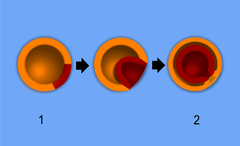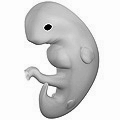Embryology: Difference between revisions
→History: further embryologists |
Tag: section blanking |
||
| Line 32: | Line 32: | ||
==Modern embryology research== |
==Modern embryology research== |
||
Currently, embryology has become an important research area for studying the [[Genetics|genetic]] control of the development process (e.g. [[morphogens]]), its link to [[cell signalling]], its importance for the study of certain diseases and [[mutation]]s and in links to [[stem cell]] research. |
Currently, embryology has become an important research area for studying the [[Genetics|genetic]] control of the development process (e.g. [[morphogens]]), its link to [[cell signalling]], its importance for the study of certain diseases and [[mutation]]s and in links to [[stem cell]] research. |
||
==See also== |
|||
*[[Ontogeny]] |
|||
*[[Embryogenesis]] |
|||
*[[Recapitulation theory]] |
|||
*[[Prenatal development]] |
|||
*[[Protostomes]] |
|||
*[[Deuterostomes]] |
|||
*[[Germ layers]] |
|||
*[[Epigenesis (biology)]] |
|||
*[[Developmental biology]] |
|||
*[[Cell signalling]] |
|||
*[[Hedgehog signaling pathway]] |
|||
*[[Morphogens]] |
|||
*[[French flag model]] |
|||
*[[Embryo drawing]] |
|||
==References== |
==References== |
||
Revision as of 01:40, 30 January 2011
This article needs additional citations for verification. (July 2007) |


Embryology (from Greek ἔμβρυον, embryon, "unborn, embryo"; and -λογία, -logia) is a science which is about the development of an embryo from the fertilization of the ovum to the fetus stage. After cleavage, the dividing cells, or morula, becomes a hollow ball, or blastula, which develops a hole or pore at one end.
In bilateral animals, the blastula develops in one of two ways that divides the whole animal kingdom into two halves (see: Embryological origins of the mouth and anus). If in the blastula the first pore (blastopore) becomes the mouth of the animal, it is a protostome; if the first pore becomes the anus then it is a deuterostome. The protostomes include most invertebrate animals, such as insects, worms and molluscs, while the deuterostomes include the vertebrates. In due course, the blastula changes into a more differentiated structure called the gastrula.
The gastrula with its blastopore soon develops three distinct layers of cells (the germ layers) from which all the bodily organs and tissues then develop:
- The innermost layer, or endoderm, gives rise to the digestive organs, lungs and bladder.
- The middle layer, or mesoderm, gives rise to the muscles, skeleton and blood system.
- The outer layer of cells, or ectoderm, gives rise to the nervous system and skin.
In humans, the term embryo refers to the ball of dividing cells from the moment the zygote implants itself in the uterus wall until the end of the eighth week after conception. Beyond the eighth week, the developing human is then called a fetus. Embryos in many species often appear similar to one another in early developmental stages. The reason for this similarity is because species have a shared evolutionary history. These similarities among species are called homologous structures, which are structures that have the same or similar function and mechanism having evolved from a common ancestor.
History



As recently as the 18th century, the prevailing notion in human embryology was preformation: the idea that semen contains an embryo — a preformed, miniature infant, or "homunculus" — that simply becomes larger during development. The competing explanation of embryonic development was epigenesis, originally proposed 2,000 years earlier by Aristotle. According to epigenesis, the form of an animal emerges gradually from a relatively formless egg. As microscopy improved during the 19th century, biologists could see that embryos took shape in a series of progressive steps, and epigenesis displaced preformation as the favored explanation among embryologists.[1]
Modern embryological pioneers include Gavin de Beer, Charles Darwin, Ernst Haeckel, J.B.S. Haldane, and Joseph Needham, while much early embryology came from the work of Aristotle and the great Italian anatomists: Aldrovandi, Aranzio, Leonardo da Vinci, Marcello Malpighi, Gabriele Falloppia, Girolamo Cardano, Emilio Parisano, Fortunio Liceti, Stefano Lorenzini, Spallanzani, Enrico Sertoli, Mauro Rusconi, etc.[2] Other important contributors include William Harvey, Kaspar Friedrich Wolff, Heinz Christian Pander, Karl Ernst von Baer, August Weismann, Ernest Everett Just, and Edward B. Lewis.
After the 1950s, with the DNA helical structure being unravelled and the increasing knowledge in the field of molecular biology, developmental biology emerged as a field of study which attempts to correlate the genes with morphological change, and so tries to determine which genes are responsible for each morphological change that takes place in an embryo, and how these genes are regulated.
Vertebrate and invertebrate embryology
Many principles of embryology apply to both invertebrate animals as well as to vertebrates.[3] Therefore, the study of invertebrate embryology has advanced the study of vertebrate embryology. However, there are many differences as well. For example, numerous invertebrate species release a larva before development is complete; at the end of the larval period, an animal for the first time comes to resemble an adult similar to its parent or parents. Although invertebrate embryology is similar in some ways for different invertebrate animals, there are also countless variations. For instance, while spiders proceed directly from egg to adult form many insects develop through at least one larval stage
Modern embryology research
Currently, embryology has become an important research area for studying the genetic control of the development process (e.g. morphogens), its link to cell signalling, its importance for the study of certain diseases and mutations and in links to stem cell research.
References
- ^ Campbell et al. (p. 987)
- ^ Massimo De Felici, Gregorio Siracus, The rise of embryology in Italy: from the Renaissance to the early 20th Century, Int. J. Dev. Biol. 44: 515-521 (2000).
- ^ Parker, Sybil. "Invertebrate Embryology," McGraw-Hill Encyclopedia of Science & Technology (McGraw-Hill 1997).
Embryology - History of embryology as a science." Science Encyclopedia. Web. 06 Nov. 2009. <http://science.jrank.org/pages/2452/Embryology.html>.
"Germ layer." Encyclopædia Britannica. 2009. Encyclopædia Britannica Online. 06 Nov. 2009 <http://www.britannica.com/EBchecked/topic/230597/germ-layer>.
Further reading
- Scott F. Gilbert. Developmental Biology. Sinauer, 2003. ISBN 0-87893-258-5.
- Lewis Wolpert. Principles of Development. Oxford University Press, 2006. ISBN 0-19-927536-X.
External links
- Indiana University's Human Embryology Animations
- What is a human admixed embryo?
- UNSW Embryology Large resource of information and media
- Definition of embryo according to Webster
